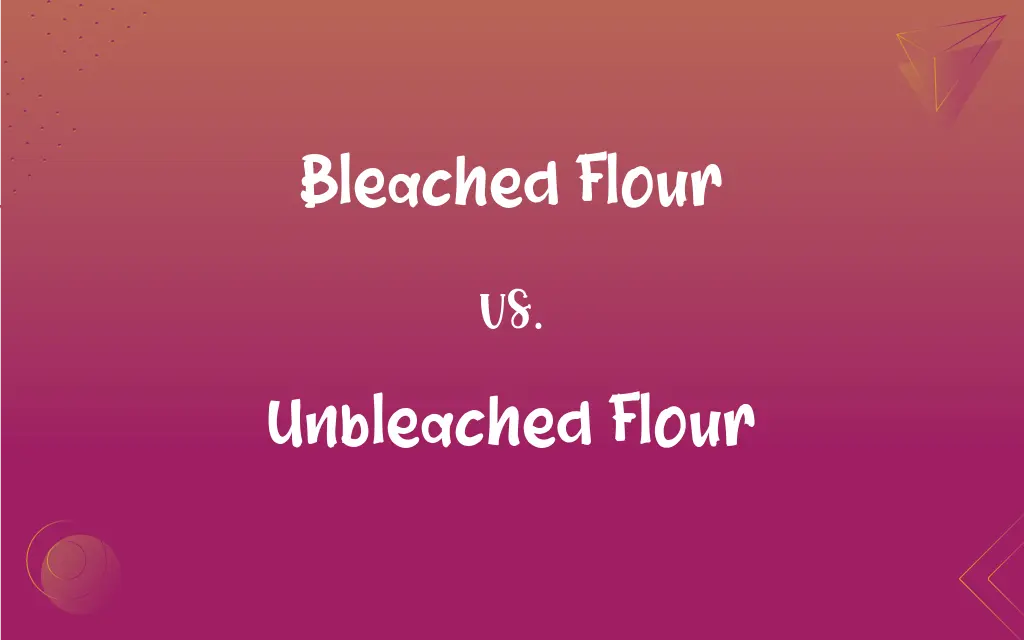Bleached Flour vs. Unbleached Flour: What's the Difference?
Edited by Aimie Carlson || By Harlon Moss || Published on March 1, 2024
Bleached flour is chemically treated to whiten and soften it; unbleached flour is naturally aged, retaining a denser, off-white color.

Key Differences
Bleached flour and unbleached flour differ primarily in their processing methods. Bleached flour is treated with chemical agents to accelerate the aging process, resulting in a whiter and finer-grain flour. This treatment not only alters the color but also affects the texture and flavor of the flour. Unbleached flour, on the other hand, is allowed to age naturally without the use of chemical bleaching agents, which gives it a denser texture and a slightly off-white color.
The use of bleached flour is often preferred in recipes that require a softer texture, such as cakes and pastries. The bleaching process alters the protein content in the flour, making it more suitable for light, airy baked goods. Unbleached flour, with its higher protein content, is often used for yeast breads and other products where a chewier texture is desired. This distinction highlights the importance of choosing the right type of flour for specific baking needs.
Nutritionally, there is little difference between bleached and unbleached flour, as the bleaching process does not significantly impact the nutrient content. However, some bakers prefer unbleached flour due to the absence of chemical agents in the aging process. The preference between the two types of flour often comes down to the specific requirements of the recipe and personal taste.
Environmental and health considerations also play a role in the choice between bleached and unbleached flour. Some consumers opt for unbleached flour to avoid the chemicals used in the bleaching process, while others may choose bleached flour for its consistency and performance in baking. It's important to consider these factors when deciding which type of flour to use.
The choice between bleached and unbleached flour depends on the desired outcome of the baking project. Both types have their place in the kitchen, and understanding their differences can help bakers achieve the best results in their culinary creations.
ADVERTISEMENT
Comparison Chart
Processing
Chemically treated to speed up aging
Naturally aged without chemicals
Color
Whiter appearance
Off-white, more natural color
Texture
Finer, softer texture
Denser, coarser texture
Common Uses
Cakes, pastries, and some cookies
Breads, pizza dough, and rustic pastries
Chemical Presence
Contains bleaching agents
Free from bleaching agents
ADVERTISEMENT
Bleached Flour and Unbleached Flour Definitions
Bleached Flour
Bleached flour has a softer texture compared to its unbleached counterpart.
For the pastry crust, bleached flour was chosen for its fine texture.
Unbleached Flour
Unbleached flour is milled flour that has not undergone chemical bleaching and retains a natural aging process.
He always uses unbleached flour for his bread recipes to enhance the texture.
Bleached Flour
This type of flour is often used in recipes where a finer texture is desired.
Bleached flour works best for the cookies she intends to decorate intricately.
Unbleached Flour
The natural aging process of unbleached flour results in a denser grain and a slightly off-white color.
Unbleached flour gives the pizza dough a robust and chewy texture.
Bleached Flour
The bleaching agents in flour can affect its flavor, often making it less pronounced.
The subtle taste of the cake can be attributed to the use of bleached flour.
Unbleached Flour
This flour type is versatile, suitable for a variety of baked goods that benefit from a chewier texture.
The rustic crust of the pie was achieved using unbleached flour.
Bleached Flour
Bleached flour is flour that has been chemically treated to hasten the aging process, resulting in a whiter color.
She used bleached flour to bake the wedding cake, ensuring a tender crumb.
Unbleached Flour
Unbleached flour is often chosen by those looking to avoid added chemicals in their baking.
For health-conscious baking, she opts for unbleached flour.
Bleached Flour
The bleaching process alters the flour's protein structure, making it more suitable for light, delicate baked goods.
Bleached flour is preferred for making fluffy pancakes.
Unbleached Flour
Preferred for yeast breads, unbleached flour contributes to a stronger gluten network.
Her sourdough loaves made with unbleached flour have an exceptional rise.
FAQs
What is unbleached flour?
Unbleached flour is naturally aged flour without chemical treatment, maintaining a denser texture and off-white color.
What is bleached flour?
Bleached flour is flour chemically treated to speed up the aging process, resulting in a whiter and softer texture.
Is there a nutritional difference between bleached and unbleached flour?
Nutritionally, they are very similar, though some prefer unbleached due to the absence of chemical agents.
Can unbleached flour be used for all baking?
Yes, unbleached flour is versatile and can be used for most baking needs, though results may vary slightly.
Are the bleaching chemicals in bleached flour safe?
Yes, the chemicals used are food-safe, but some prefer unbleached flour for a more natural option.
Can I substitute bleached flour for unbleached flour?
Yes, but the texture and color of the baked goods may slightly vary.
How is bleached flour made?
It's made by treating milled wheat flour with chemical agents to speed up its aging.
Why is flour bleached?
Flour is bleached to improve its color and texture for specific types of baking, like cakes and pastries.
Does bleached flour affect the flavor of baked goods?
It can, but the difference is minimal and often overshadowed by other ingredients.
Does bleached flour have a finer texture?
Yes, the bleaching process results in a finer, softer texture.
Is unbleached flour more expensive?
Prices vary, but unbleached flour can sometimes be slightly more expensive due to its natural processing.
Is unbleached flour better for bread?
Yes, its higher protein content and denser texture are ideal for bread.
What are common uses for unbleached flour?
It's preferred for bread, pizza dough, and rustic pastries.
How should I store bleached and unbleached flour?
Both should be stored in a cool, dry place, preferably in an airtight container.
Does unbleached flour have a longer shelf life?
Not necessarily; storage conditions are more important for shelf life.
What are common uses for bleached flour?
It's often used in cakes, pastries, and other delicate baked goods.
Can I use bleached flour for pizza dough?
You can, but unbleached flour is typically preferred for its chewier texture.
Do professional bakers use bleached or unbleached flour?
It depends on the recipe and desired outcome; both types are used professionally.
Is bleached flour common outside the US?
It's less common in some countries, where unbleached flour is the norm.
How is unbleached flour made?
It's simply milled wheat flour that's allowed to age naturally without chemical treatments.
About Author
Written by
Harlon MossHarlon is a seasoned quality moderator and accomplished content writer for Difference Wiki. An alumnus of the prestigious University of California, he earned his degree in Computer Science. Leveraging his academic background, Harlon brings a meticulous and informed perspective to his work, ensuring content accuracy and excellence.
Edited by
Aimie CarlsonAimie Carlson, holding a master's degree in English literature, is a fervent English language enthusiast. She lends her writing talents to Difference Wiki, a prominent website that specializes in comparisons, offering readers insightful analyses that both captivate and inform.
































































